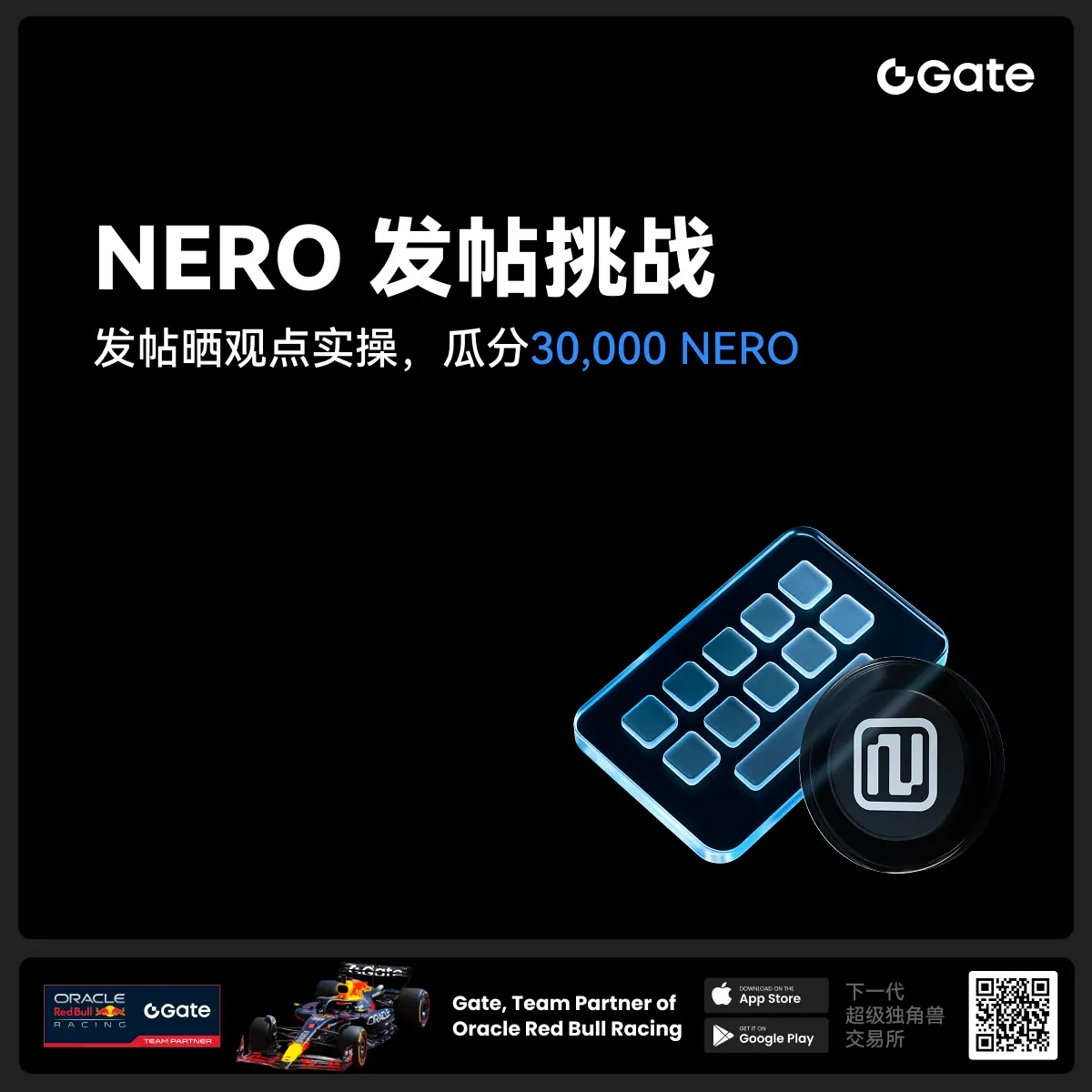- 话题1/3
54k 热度
39k 热度
52k 热度
9k 热度
23k 热度
- 置顶
- 🎉 #CandyDrop合约挑战# 正式开启!参与即可瓜分 6 BTC 豪华奖池!
📢 在 Gate 广场带话题发布你的合约体验
🎁 优质贴文用户瓜分$500 合约体验金券,20位名额等你上榜!
📅 活动时间:2025 年 8 月 1 日 15:00 - 8 月 15 日 19:00 (UTC+8)
👉 活动链接:https://www.gate.com/candy-drop/detail/BTC-98
敢合约,敢盈利
- 🎉 攒成长值,抽华为Mate三折叠!广场第 1️⃣ 2️⃣ 期夏季成长值抽奖大狂欢开启!
总奖池超 $10,000+,华为Mate三折叠手机、F1红牛赛车模型、Gate限量周边、热门代币等你来抽!
立即抽奖 👉 https://www.gate.com/activities/pointprize?now_period=12
如何快速赚成长值?
1️⃣ 进入【广场】,点击头像旁标识进入【社区中心】
2️⃣ 完成发帖、评论、点赞、发言等日常任务,成长值拿不停
100%有奖,抽到赚到,大奖等你抱走,赶紧试试手气!
截止于 8月9日 24:00 (UTC+8)
详情: https://www.gate.com/announcements/article/46384
#成长值抽奖12期开启#
- 📢 Gate广场 #NERO发帖挑战# 秀观点赢大奖活动火热开启!
Gate NERO生态周来袭!发帖秀出NERO项目洞察和活动实用攻略,瓜分30,000NERO!
💰️ 15位优质发帖用户 * 2,000枚NERO每人
如何参与:
1️⃣ 调研NERO项目
对NERO的基本面、社区治理、发展目标、代币经济模型等方面进行研究,分享你对项目的深度研究。
2️⃣ 参与并分享真实体验
参与NERO生态周相关活动,并晒出你的参与截图、收益图或实用教程。可以是收益展示、简明易懂的新手攻略、小窍门,也可以是行情点位分析,内容详实优先。
3️⃣ 鼓励带新互动
如果你的帖子吸引到他人参与活动,或者有好友评论“已参与/已交易”,将大幅提升你的获奖概率!
NERO热门活动(帖文需附以下活动链接):
NERO Chain (NERO) 生态周:Gate 已上线 NERO 现货交易,为回馈平台用户,HODLer Airdrop、Launchpool、CandyDrop、余币宝已上线 NERO,邀您体验。参与攻略见公告:https://www.gate.com/announcements/article/46284
高质量帖子Tips:
教程越详细、图片越直观、互动量越高,获奖几率越大!
市场见解独到、真实参与经历、有带新互动者,评选将优先考虑。
帖子需原创,字数不少于250字,且需获得至少3条有效互动
- 🎉 亲爱的广场小伙伴们,福利不停,精彩不断!目前广场上这些热门发帖赢奖活动火热进行中,发帖越多,奖励越多,快来GET你的专属好礼吧!🚀
1️⃣ #GateLaunchpad上线IKA# |IKA认购体验
在Gate广场带话题晒出你的IKA Launchpad认购体验,4位幸运分享者讲瓜分$200分享奖池!
详情 👉️ https://www.gate.com/post/status/12566958
2️⃣ #ETH冲击4800# |行情分析预测
大胆发帖预测ETH走势,展示你的市场洞察力!10位幸运用户将平分0.1 ETH 奖励!
详情 👉️ https://www.gate.com/post/status/12322403
3️⃣ #创作者活动第二期# |ZKWASM话题
在广场或推特发布与 ZKWASM 或其交易活动相关的原创内容,瓜分4,000枚ZKWASM!
详情 👉️ https://www.gate.com/post/status/12525794
4️⃣ #Gate广场征文活动第二期# |ERA话题
谈谈你对ERA的观点/体验,参与并推广活动,700 ERA大奖等你赢!
详情 👉️ https://www.gate.com/post/status/12361653
5️⃣ #MBG任务挑战# |MBG话题
分享你对MBG的洞察,积极参与和推广MBG活动,20位小 - 🎉Gate 2025 上半年社区盛典:内容达人评选投票火热进行中 🎉
🏆 谁将成为前十位 #Gate广场# 内容达人?
投票现已开启,选出你的心头好
🎁赢取 iPhone 16 Pro Max、限量周边等好礼!
📅投票截止:8 月 15 日 10:00(UTC+8)
立即投票: https://www.gate.com/activities/community-vote
活动详情: https://www.gate.com/announcements/article/45974
Stripe收购Bridge:11亿美元布局稳定币支付新时代
Stripe收购Bridge:稳定币时代的巨头布局
稳定币正在席卷全球金融市场,其同比增长率超过50%,全球交易结算量已经是Visa的两倍多。在这一背景下,美国支付巨头Stripe以11亿美元收购稳定币API服务提供商Bridge,引发了业界广泛关注。本文将深入分析稳定币的崛起、Bridge的业务模式以及Stripe的收购逻辑。
一、稳定币的崛起
近期一份加密货币报告指出,稳定币已成为Web3领域最显著的"杀手级应用"之一。得益于智能手机的普及和区块链技术的落地,稳定币正在推动一场前所未有的金融赋权运动。
稳定币极大地简化了价值转移过程。当前,其每季度交易额已是某大型支付公司的两倍多,年度资产结算价值达数万亿美元,充分证明了其实用性。从日活跃地址来看,稳定币占每日加密货币使用量的近三分之一,仅次于去中心化金融(DeFi)。
根据某支付巨头的报告,稳定币的总供应量约为1700亿美元,每年结算价值数万亿美元的资产。链上每月约有2000万个地址进行稳定币交易,超过1.2亿个地址持有非零稳定币余额。这些数据表明,稳定币正在形成一个与传统金融体系平行的货币系统。
值得注意的是,稳定币在非加密领域的应用也日益广泛,包括汇款、跨境支付、工资发放、贸易结算和商户支付等。多家主要金融公司和国际组织都在积极探索稳定币支付的潜力。
二、Bridge的业务模型
Bridge由Sean Yu和Zach Abrams创立,是一家提供稳定币API服务的公司。其核心产品包括Orchestration API和Issuance API,前者帮助Web2公司集成稳定币支付,后者支持用户发行自有稳定币。
Bridge的服务涵盖稳定币跨链交易、法币/加密货币出入金承兑以及虚拟银行账户等功能,旨在为Web2用户提供更加便捷的稳定币使用体验。该公司已吸引了包括某知名航天公司在内的众多客户,年支付处理额超过50亿美元。
在融资方面,Bridge此前已从多家知名投资机构筹集了5800万美元,最近一轮估值为2亿美元。此次11亿美元的收购价格代表着5.5倍的溢价,创下了加密行业迄今最大的收购交易记录。
三、Stripe与Bridge的战略合作
Stripe收购Bridge是稳定币崛起大趋势下的重要一步。双方的融合将进一步推动Stripe的加密支付战略落地,使其能够更高效地处理稳定币交易,提升交易的透明度和安全性。
Bridge在官方声明中表示,两家公司将共同加速代币化美元的采用和实用性,让全球用户更便捷地转移、存储和消费货币。他们认为,稳定币正在成为全球资金流动的核心基础设施,代表了一个全新的支付平台。
四、Stripe的加密布局
Stripe近期在加密领域动作频频。今年10月,该公司重新为美国商户开放加密支付网关,支持通过多个主流区块链接受稳定币支付。此外,Stripe还与多家加密公司建立了合作关系,包括将某Layer 2解决方案纳入其加密支付产品。
Stripe的加密业务主要聚焦于两个方向:法币与加密货币的转换通道(On/Off Ramp)以及加密货币和稳定币的跨链结算。收购Bridge将帮助Stripe快速完善这些功能,更好地服务现有客户,并拓展新的市场机会。
五、支付巨头的稳定币战略
除Stripe外,其他支付巨头也在积极布局稳定币领域。某大型支付平台去年在以太坊上发行了自己的稳定币,今年又将其扩展到Solana网络。该公司正在积极推动其稳定币的开发者生态建设,并提出了稳定币支付迈向大规模采用的三阶段演进思路。
另一家支付巨头则专注于比特币领域,持有大量比特币资产,并在加密领域有多项布局。
六、结语
随着稳定币市场的不断扩大,未来可能会出现更多规模更大的并购交易。支付巨头们正在加速布局,为即将到来的稳定币时代做准备。在这个快速发展的领域中,拥有先进技术和广泛合作关系的公司将占据优势地位。